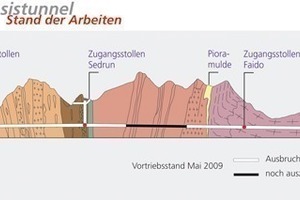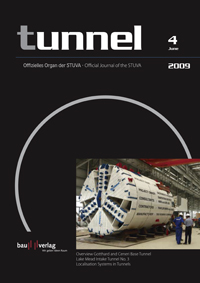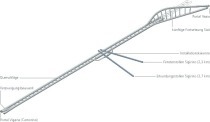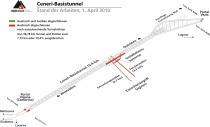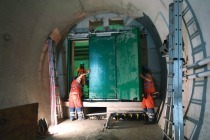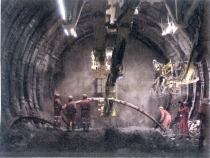Focus on the Gotthard Axis
Work on the new Gotthard Line is forging ahead according to plan. 2008 has been assessed both by the Bundesamt für Verkehr (BAV) as client as well as the NEAT supervisory delegation from the Swiss authorities as a highly successful year. In addition to the progress made in construction the clearly defined new political marginal conditions applied since the autumn of 2008 have led to this appraisal. As things are at present nothing is standing in the way of opening the Gotthard Base Tunnel in 2017 and the Ceneri Base Tunnel in 2019.
Since September 16th, 2008 the new total credit for NEAT (Trans-Alpine routes) passed by parliament has been in force. Among other things it assures the financing of the Gotthard Base Tunnel, the Ceneri Base Tunnel and related new routes running on the surface. Thanks to comprehensive, systematic risk management the issue of the likely final costs and the remaining risks could be resolved between the client and the AlpTransit Gotthard AG as contractor.
The agreed superordinated cost and scheduling targets as so-called focal targets are the guideline for all those involved in the project, also applying to day-to-day business (Fig. 1).
Gotthard Base Tunnel
After only 4,901 m of tunnel was completed in 2007 no less than 16,958 m was produced in 2008. This striking increase resulted from the start of the high-performance excavations in the Erstfeld part-section and thanks to the considerably improved rates of advance due to more favourable subsurface conditions in the Faido part-section.
An even better performance was prevented by the fact that as from May 2008 up till the end of the year an extensive fault zone was encountered in the Sedrun part-section. As a consequence only 126 m of tunnel was driven in the eastern tube, something corresponding to a month’s progress given undisturbed conditions. In the following the driving operations for the various part-sections are examined at length.
Up till April 1st, 2009, 129.3 km of tunnels, galleries and shafts, had been driven for the Gotthard Base Tunnel. In other words 84 % of the total excavation of 153.3 km has been executed.
In addition to the driving operations the concreting work for the inner vault are running according to schedule. The single-track tubes in the Amsteg and Bodio part-sections have almost been completed. As from the end of 2009 these sections will be handed over to the contractors responsible for the rail technology (Fig. 2). However, the rail technology can only be properly installed providing that the tunnel’s so-called roughwork furnishing has been accomplished beforehand. This applies to element such as doors and gates (Fig. 3), ventilation systems, double floors etc. Work on installing these elements began in autumn 2008 in the Bodio and Amsteg part-sections and is due to start shortly in the Sedrun part-section (Fig. 4).
Ceneri Base Tunnel
In the meantime construction is forging ahead on the Ceneri Base Tunnel at all 3 main sites, namely at the south portal in Vezia, the intermediate point of attack at Sigirino and at the north portal in Vigana. All 3 construction sites represent special challenges. The south portal is constricted in a built-up and susceptible district on the suburbs of Lugano. Furthermore a road tunnel has to be crossed with only a few metres of overburden to spare.
In Sigirino the access tunnel has been completely excavated. As far as the main drives are concerned, which are scheduled to start in 2010 from the bottom point of the tunnel towards the north and south, the chambers needed for the underground installations are currently being excavated. In addition the systems for logistics, material preparation and storage are also being set up here.
At the north portal the work designed to undercut the A2 motorway has started. This also represents an extremely tricky operation as a slope with only a few metres of overburden created when the motorway was being built has to be penetrated by mining means (Fig. 5).
Deadlines
The Gotthard Base Tunnel is scheduled to open at the end of 2017. At the end of 2006 and 2008 the AlpTransit Gotthard AG had the scenarios for the main breakthrough at the Gotthard Base Tunnel extensively analysed by the Inge-nieurgemeinschaft Gotthard-Basistunnel Süd (Fig. 6).
Thanks to the elimination of substantial residual risks pertaining to the subsurface the accuracy of the prognosis considerably increased at the end of 2008. At the end of 2006 the main breakthrough was predicted for August 2011 at km 128.9. The range of the prognosis amounted to roughly
+/–2.2 km in distance and –18 to +32 months with respect to the point in time for the breakthrough.
The study at the end of 2008 forecasts the final breakthrough to occur in February 2011 at km 127.5 in other words 1.4 km further to the north than determined 2 years previously.
The spread diminished to –0.7/+1.4 km regarding distance and to –4/+9 months with respect to the deadline (Fig. 7).
The reason for these corrections relates to the updated assessment of the subsurface risks as well as changes affecting orders in the Faido part-section, which have led to the TBM drives being speeded up (reduction of the advance exploratory measures in the time-bound second tunnel tube).
The main construction work for the Ceneri Base Tunnel is to be awarded in summer 2009 so that driving operations can commence in mid-2010. The tunnel is due to be opened at the end of 2019.
Costs
The cost and risk situation is assessed by the AlpTransit Gotthard AG along the entire axis on a quarterly basis. In summer 2007 the probable project costs amounted to CHF 11.8 bill. (Gotthard Axis, price basis 1998) on the basis of a comprehensive new assessment. The sum of quantifiable risks amounted to CHF 2.7 bill.
At the end of 2008 the probable final costs were estimated at around CHF 11.9 bill. In the meantime the quantifiable risks could be reduced by CHF 0.3 bill. to CHF 2.4 bill. after the elimination of substantial subsurface risks (Fig. 8).

